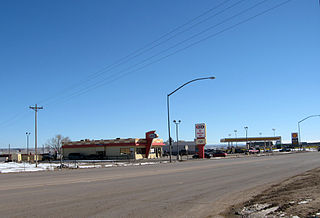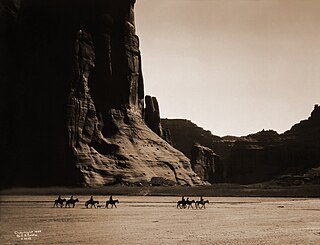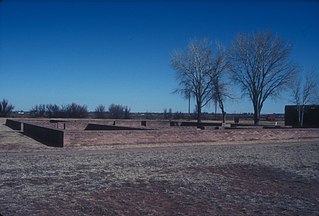
Christopher Houston Carson, better known as Kit Carson, was an American frontiersman. He was a fur trapper, wilderness guide, Indian agent, and U.S. Army officer. He became a frontier legend in his own lifetime by biographies and news articles, and exaggerated versions of his exploits were the subject of dime novels. His understated nature belied confirmed reports of his fearlessness, combat skills, tenacity, and profound effect on the westward expansion of the United States. Although very famous for much of his life, historians in later years have written that Kit Carson did not like, want, or even fully understand the celebrity that he experienced during his life.

Chinle is a census-designated place (CDP) in Apache County, Arizona. The name in Navajo means "flowing out" and is a reference to the location where the water flows out of the Canyon de Chelly. The population was 4,518 at the 2010 census.

Ganado is a chapter of the Navajo Nation and census-designated place (CDP) in Apache County, Arizona, United States. The population was 1,210 at the 2010 census.

The Navajo Nation is an American Indian territory covering about 17,544,500 acres, occupying portions of northeastern Arizona, southeastern Utah, and northwestern New Mexico in the United States. This is the largest land area retained by an indigenous tribe in the United States, with a population of 173,667 as of 2010.

The Four Corners is a region of the United States consisting of the southwestern corner of Colorado, southeastern corner of Utah, northeastern corner of Arizona, and northwestern corner of New Mexico. The Four Corners area is named after the quadripoint at the intersection of approximately 37° north latitude with 109° 03' west longitude, where the boundaries of the four states meet, and are marked by the Four Corners Monument. It is the only location in the United States where four states meet. Most of the Four Corners region belongs to semi-autonomous Native American nations, the largest of which is the Navajo Nation, followed by Hopi, Ute, and Zuni tribal reserves and nations. The Four Corners region is part of a larger region known as the Colorado Plateau and is mostly rural, rugged, and arid. In addition to the monument, commonly visited areas within Four Corners include Monument Valley, Mesa Verde National Park, Chaco Canyon, Canyons of the Ancients National Monument and Canyon de Chelly National Monument. The most populous city in the Four Corners region is Farmington, New Mexico, followed by Durango, Colorado.

Bury My Heart at Wounded Knee: An Indian History of the American West is a 1970 book by American writer Dee Brown that covers the history of Native Americans in the American West in the late nineteenth century. The book expresses details of the history of American expansionism from a point of view that is critical of its effects on the Native Americans. Brown describes Native Americans' displacement through forced relocations and years of warfare waged by the United States federal government. The government's dealings are portrayed as a continuing effort to destroy the culture, religion, and way of life of Native American peoples. Helen Hunt Jackson's 1881 book A Century of Dishonor is often considered a nineteenth-century precursor to Dee Brown's writing.

The Long Walk of the Navajo , also called the Long Walk to Bosque Redondo, refers to the 1864 deportation and attempted ethnic cleansing of the Navajo people by the United States federal government. Navajos were forced to walk from their land in what is now Arizona to eastern New Mexico. Some 53 different forced marches occurred between August 1864 and the end of 1866. Some anthropologists claim that the "collective trauma of the Long Walk...is critical to contemporary Navajos' sense of identity as a people".

Canyon de Chelly National Monument was established on April 1, 1931, as a unit of the National Park Service. Located in northeastern Arizona, it is within the boundaries of the Navajo Nation and lies in the Four Corners region. Reflecting one of the longest continuously inhabited landscapes of North America, it preserves ruins of the indigenous tribes that lived in the area, from the Ancestral Puebloans to the Navajo. The monument covers 83,840 acres and encompasses the floors and rims of the three major canyons: de Chelly, del Muerto, and Monument. These canyons were cut by streams with headwaters in the Chuska Mountains just to the east of the monument. None of the land is federally owned. Canyon de Chelly is one of the most visited national monuments in the United States.

Northern Arizona is an unofficial, colloquially-defined region of the U.S. state of Arizona. Generally consisting of Apache, Coconino, Mohave, and Navajo counties, the region is geographically dominated by the Colorado Plateau, the southern border of which in Arizona is called the Mogollon Rim.

Fort Wingate is near Gallup, New Mexico. There were two other locations in New Mexico which were called Fort Wingate: Seboyeta, New Mexico (1849-1862) and San Rafael, New Mexico (1862-1868). The most recent Fort Wingate (1868-1993) was established at the former site of Fort Lyon, on Navajo territory, initially to control and "protect" the large Navajo tribe to its north. The Fort at San Rafael was the staging point for the Navajo deportation known as the Navajo's Long Walk. From 1870 onward the garrison near Gallup was concerned with Apaches to the south, and through 1890 hundreds of Navajo Scouts were enlisted at the fort.

The term Navajo Wars covers at least three distinct periods of conflict in the American West: the Navajo against the Spanish ; the Navajo against the Mexican government ; and the Navajo against the United States. These conflicts ranged from small-scale raiding to large expeditions mounted by governments into territory controlled by the Navajo. The Navajo Wars also encompass the widespread raiding that took place throughout the period; the Navajo raided other tribes and nearby settlements, who in return raided into Navajo territory, creating a cycle of raiding that perpetuated the conflict.

Chief Manuelito (1818–1893) was one of the principal headmen of the Diné people before, during and after the Long Walk Period. His name means Little Manuel in Spanish. He was born to the Bit'ahnii or ″Folded Arms People Clan″, near the Bears Ears in southeastern Utah about 1818. As many Navajo, he was known by different names depending upon context. He was Ashkii Diyinii, Dahaana Baadaané, Hastiin Ch'ilhaajinii and as Nabááh Jiłtʼaa to other Diné, and non-Navajo nicknamed him "Bullet Hole".

Fort Sumner was a military fort in New Mexico Territory charged with the internment of Navajo and Mescalero Apache populations from 1863 to 1868 at nearby Bosque Redondo.

The Apache Scouts were part of the United States Army Indian Scouts. Most of their service was during the Apache Wars, between 1849 and 1886, though the last scout retired in 1947. The Apache scouts were the eyes and ears of the United States military and sometimes the cultural translators for the various Apache bands and the Americans. Apache scouts also served in the Navajo War, the Yavapai War, the Mexican Border War and they saw stateside duty during World War II. There has been a great deal written about Apache scouts, both as part of United States Army reports from the field and more colorful accounts written after the events by non-Apaches in newspapers and books. Men such as Al Sieber and Tom Horn were sometimes the commanding officers of small groups of Apache Scouts. As was the custom in the United States military, scouts were generally enlisted with Anglo nicknames or single names. Many Apache Scouts received citations for bravery.

Barboncito (1821–1871) was a famous Navajo political and spiritual leader. His name means bearded in Spanish. He also was known as Hástiin Dághá, Hastiin Daagi, Bistłahałání, and Hózhǫ́ǫ́jí Naatʼááh. Barboncito was born into the Ma'íí deeshgíízhiníí clan at Cañon de Chelly in 1820 and was a brother to Delgadito. He was a signatory of several treaties between the United States and Navajos, including the Doniphan Treaty of 1846, which was an attempt to establish peace between the Navajo and whites during the Mexican War. This treaty proved to be unsuccessful, as not all of the Navajo Chiefs were willing to become signatory to it. This would later lead to armed rebellion against the United States where Barboncito worked together with another Navajo, Manuelito, in order to try and stop the forced relocation of Navajo tribe members to Bosque Redando. Barboncito was the Head Chief of the Navajo when the Bosque Redondo Treaty of 1868 was signed. This treaty contained articles which would end hostilities between the United States and the Navajo people, as well as allowing them to return to their ancestral land at Cañon de Chelly in Arizona and having a reservation established there. The impact of this aspect of the treaty was the end of the Long Walk of the Navajo which had claimed the lives of thousands of Navajo people. Of all the Navajos of his time, Barboncito is probably most responsible for the long-term success of the Navajo culture and relations with non-Navajos. As well as being established as a skillful negotiator and leader of the Navajo people. Shortly after the enactment of the Bosque Redando Treaty, Barboncito died in 1871 at Cañon de Chelly.

The Shape Shifter is the eighteenth crime fiction novel in the Joe Leaphorn / Jim Chee Navajo Tribal Police series by Tony Hillerman, first published in 2006. It was a New York Times best-seller and the last Chee/Leaphorn novel by Hillerman published before Hillerman's death on October 26, 2008.

The Battle of Pecos River was fought in 1864 during the Navajo Wars. United States Army troops and Apache Scouts defeated a force of Navajo warriors next to the Pecos River in New Mexico. It is notable for being one of the many Indian war battles involving the California Column.
The Skirmish in Doubtful Canyon took place on May 3, 1864 between a company of infantry from the California Column and a band of about 100 Apaches. The fighting occurred near Steins Peak in Doubtful Canyon, Arizona Territory. Doubtful Canyon, along with Apache Pass in Arizona and Cookes Canyon, in New Mexico was a favored location for an ambush by the Apache along the Butterfield Overland Mail route.

The Defiance Plateau, part of the geologic Defiance Uplift, is an approximately 75-mile (121 km) long, mostly north-trending plateau of Apache County, Arizona, with its east and southeast perimeter, as parts of San Juan and McKinley Counties, New Mexico.

Chinle Wash is an arroyo, tributary to Chinle Creek in Apache County, Arizona. Its name is derived from the Navajo word ch'inili meaning 'where the waters came out'. Its sources is in Canyon de Chelly National Monument where Canyon de Chelly and Canyon del Muerto have their confluence at an elevation of 5,616 feet at 36°08′35″N109°29′17″W. It then trends northwest to its confluence with Laguña Creek where it forms Chinle Creek, 7 miles northeast of Dennehotso, Arizona at an elevation of 4,774 feet / 1,455 meters.



















